Blog
A Sacred Spot in Chicago’s Loop
By: Rebekah Coffman
Apr 22 2024
Passover 2024 begins at sundown Monday, April 22, and ends at sundown on Tuesday, April 30. In this blog post, CHM curator of religion and community history Rebekah Coffman writes about the Chicago Loop Synagogue and a Passover Seder shared by its rabbi, Irving Rosenbaum, in 1966.
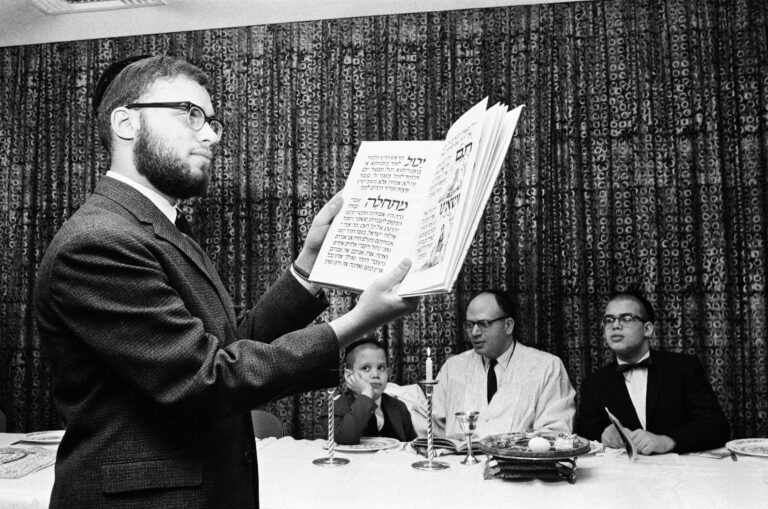
A Seder table with Rabbi Irving Rosenbaum (seated, center) and his sons at Chicago Loop Synagogue, March 31, 1966. ST-11005561-0005, Chicago Sun-Times collection, CHM
This set of images shows a staged Passover meal taking place at the Chicago Loop Synagogue in 1966. Featured center is Roy Rosenbaum (age 19) reading to his father, Rabbi Irving Rosenbaum, and his two brothers, Alan (age 6) and Don (age 15). Roy is holding a Haggadah, a book that details the order of the Passover meal, known as the seder (seder, in fact, means “order”). It outlines stories from the Book of Exodus and includes a series of blessings, songs, actions, and ceremonial foods and drinks as a guide for families and communities through the symbolic meal.
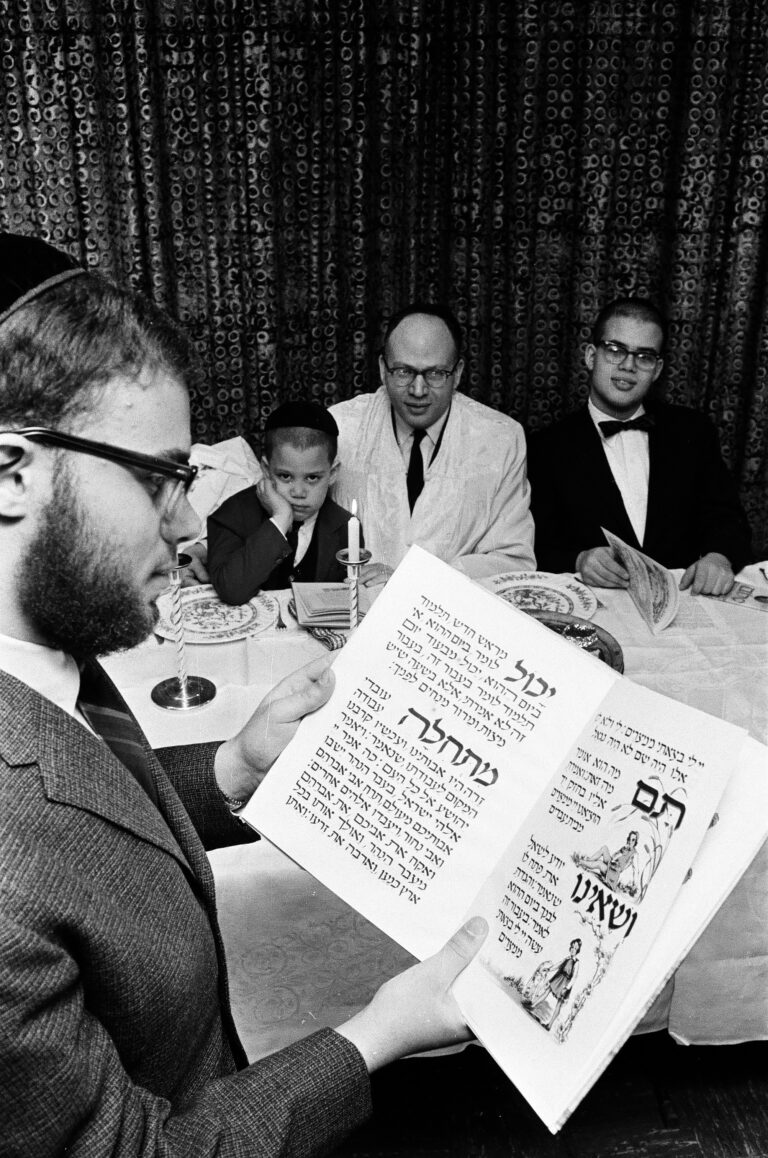
Roy Rosenbaum reads from a Haggadah during a Seder at Chicago Loop Synagogue, March 31, 1966. ST-11005561-0001, Chicago Sun-Times collection, CHM
Roy is reading pages from a section in the seder that discusses four sons or four children: the wise, the wicked, the simple-natured, and the one who doesn’t know how to ask. These children represent different ways of approaching and learning about the story of Passover. The Haggadah next shares the Exodus story as a movement from slavery toward freedom. While seders are often something done at home with family, they may also be done in synagogues or in larger community, all with an emphasis of passing the story through the generations and recalling humankind’s search for freedom.
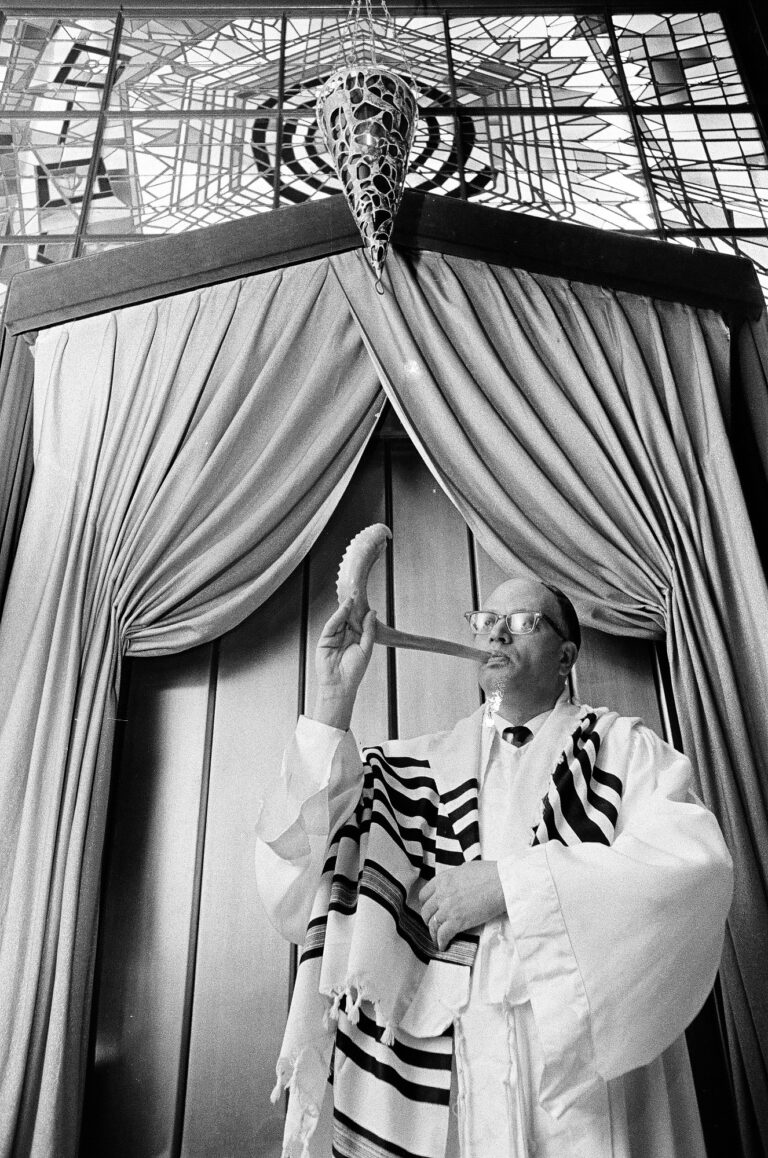
Rabbi Irving J. Rosenbaum blows a shofar during Rosh Hashanah services at the Chicago Loop Synagogue, September 20, 1968. ST-11005551-0007, Chicago Sun-Times collection, CHM
Rabbi Irving J. Rosenbaum (c. 1922–2005) served as rabbi of Chicago Loop Synagogue for 14 years. Born in Omaha, Nebraska, Rabbi Rosenbaum moved to the Chicago area for school at age 16. He attended the University of Chicago in Hyde Park and Hebrew Theological College in Skokie, graduating in the 1940s. In 1946, he served as the National Director of the Department of Interreligious Cooperation for the Anti-Defamation League of B’nai B’rith. Rabbi Rosenbaum was especially dedicated to education, including in interfaith settings. For example, he produced a film and accompanying booklet for non-Jews called Your Neighbor Celebrates to explain Jewish religious practice and holidays. This fervent interest in religious education was passed down to the next generation, as all three of his sons would go on to also become rabbis.
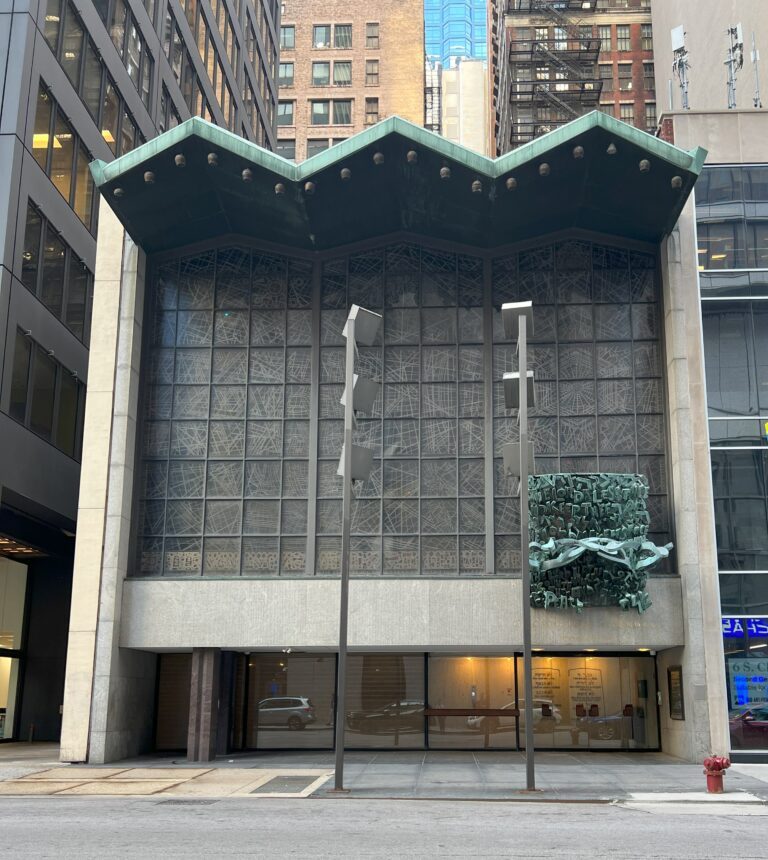
Chicago Loop Synagogue as seen from Clark Street, 2022. Photograph by Rebekah Coffman
Chicago Loop Synagogue was founded in 1929 to provide a space for Jewish professionals working downtown. The community began by renting different spaces around the Loop for daily and Friday evening (Kiddush) prayers. In the 1950s, they were inspired to construct a purpose-built synagogue after seeing Temple Har Zion in River Forest, Illinois, completed in 1951. They commissioned Har Zion’s architects—Loebl, Schlossman, and Bennet—to design their current building on South Clark Street between Madison and Monroe Streets, completed in 1958.
Today known as Loebl, Schlossman, and Hackl, the synagogue designers’ firm was founded in 1925, with the practice’s name shifting in passing decades as new partners and collaborators joined and left over time. Their founding namesakes, Jerrold Loebl and Norman Schlossman, had grown up in Hyde Park and both studied architecture at Armour Institute of Technology (today Illinois Institute of Technology). Richard M. Bennet, who was originally from Pennsylvania and had studied at Harvard University, joined Loebl and Schlossman in 1947, shifting the practice’s name to Loebl, Schlossman and Bennet for the next two decades until joined by a fourth architect, Edward Dart, in 1965. They designed several impressive synagogues, including Lakeview’s Temple Sholom (1928), but their legacy extends much further through various planned projects and urban renewal schemes, especially in the Bronzeville neighborhood, as well as public housing, suburban developments such as Park Forest, and downtown Chicago’s Richard J. Daley Center.
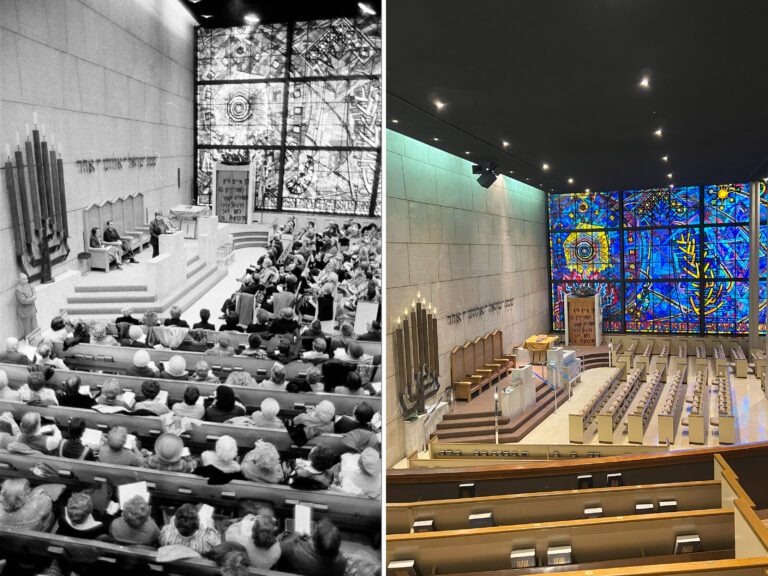
Left: Women speak to the congregation regarding Soviet Jews at the Chicago Loop Synagogue, December 10, 1979. ST-60002959-0001, Chicago Sun-Times collection, CHM. Right: Loop Synagogue sanctuary interior, 2022. Photograph by Rebekah Coffman
Loop Synagogue was designed not only to be architecturally and artistically beautiful but also includes layers of symbolic meaning as well as practical design to facilitate Orthodox Jewish needs. Two primary examples of this are in the main worship space. First, in place of an elevator, a long ramp leads between the first and second story to facilitate easy access for congregants unable to use the stairs. Since a traditional elevator uses electricity, its use would be prohibited on Shabbat for Orthodox Jews, so the ramp permits moving between levels while aligning with this prohibition.
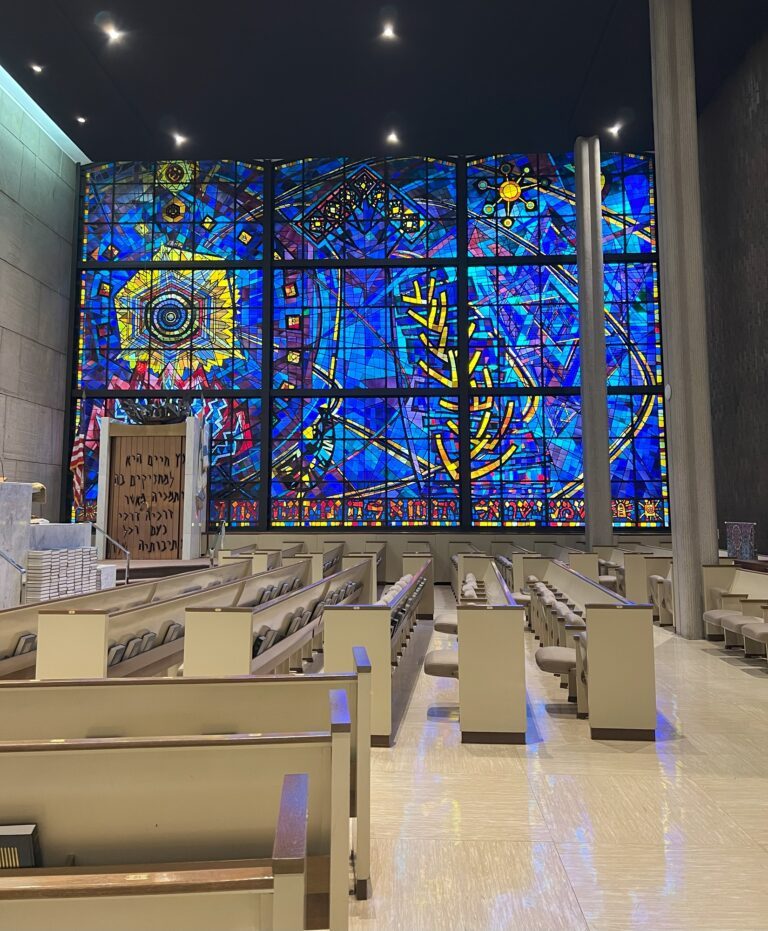
Stained glass window by Abraham Rattner in Loop Synagogue’s sanctuary, 2022. Photograph by Rebekah Coffman
Similarly, as lights also usually require electricity, the sanctuary’s east side has an extraordinary stained glass window that runs nearly floor to ceiling. Designed by Abraham Rattner and considered one of the finest windows of its kind, its impressive size also serves a practical purpose by letting in plentiful, colorfully filtered light. The window, called Let There Be Light, is based on the scripture Genesis 1:3 and includes symbolic and literal references to light, including flames as a symbol of Divine presence and a seven-branched Menorah symbolizing inner light.
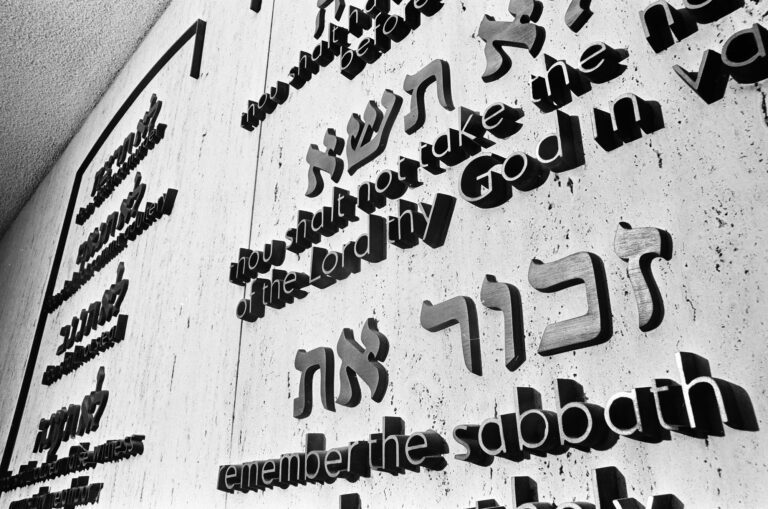
View of the Ten Commandments in both Hebrew and English at the Chicago Loop Synagogue, May 21, 1969. ST-19042097-0003, Chicago Sun-Times collection, CHM
Another beautifully symbolic element sits at the threshold of the building, visible from the street and just inside the synagogue’s entrance doors. A sculpture of the Ten Commandments, both in English and Hebrew, acts as bridge from the outside world to the inside’s sacred space.
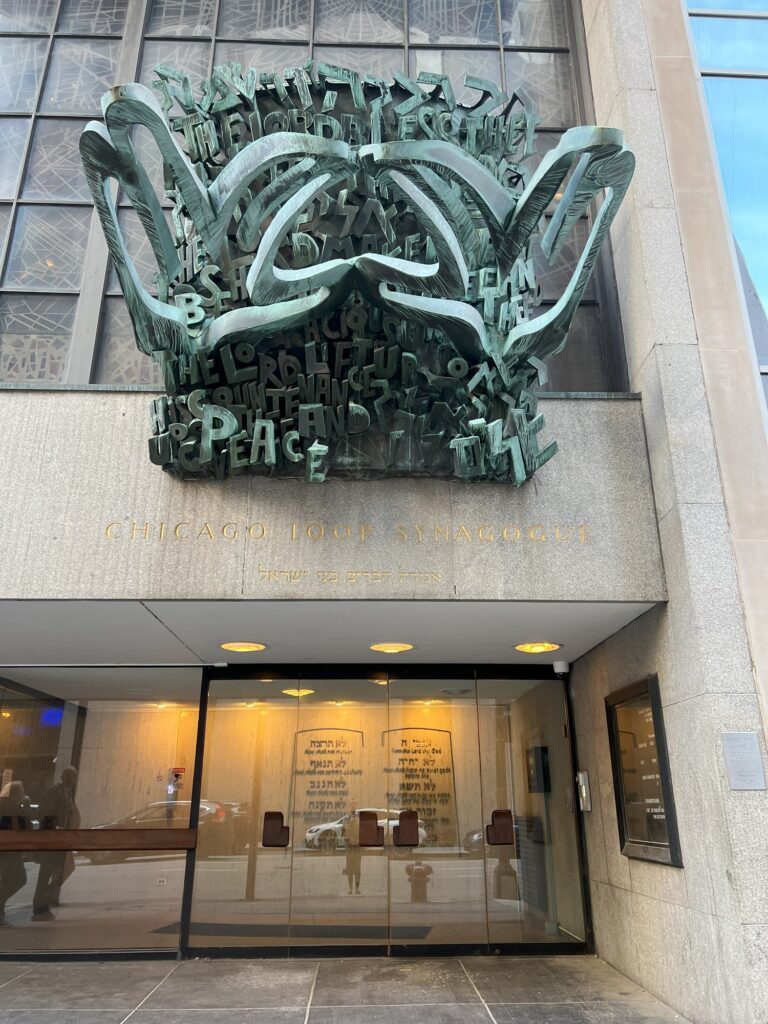
Hands of Peace sculpture by Nehemia Azaz above the entrance to Chicago Loop Synagogue, 2022. Photograph by Rebekah Coffman
Religious practice downtown has shifted dramatically in recent years, compounded with the onset of the COVID-19 pandemic, leading to a significant decline in membership for the synagogue. The synagogue’s community, led by President Lynn Zoldan, continues to think of creative ways to serve their Jewish congregation while welcoming new uses to help preserve the space for the future. Outside the synagogue’s entrance on Clark Street is Nehemia Henri Azaz’s impressive Hands of Peace sculpture, which places the outstretched hands of the priestly benediction said over congregants against a backdrop of its very words in both English and Hebrew, serving as a blessing for those outside passing by.
Further Reading
- Read the entry on Jews in the Encyclopedia of Chicago
- Read the entry on Judaism in the Encyclopedia of Chicago
- Read the entry on the Loop in the Encyclopedia of Chicago
- Read the blog post “Hag Pesach Sameach: Passover and Chicago’s Jewish Communities“
- View the HABS documentation for Chicago Loop Synagogue

